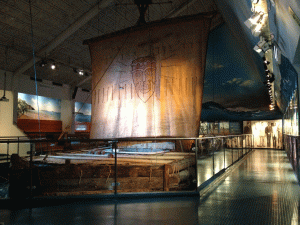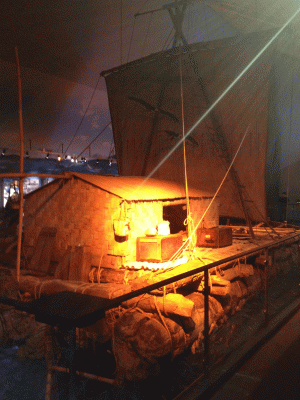School of Drama Associate Professor Scott Magelssen serves as guest blogger this week. Scott’s current research is on interactive performance events in which participants are immersed into live, simulated, experiential environments and take on active roles in those environments. Using the term “simming,” borrowed from online and computer gaming, Scott considers the ways these events, while used for varying purposes (educational, entertainment, business, military, etc.), use tools from theatre and performance to help make meaning for the producers and participants. Examples range from interactive Underground Railroad reenactments at living history museums, prom-season mock drunk-driving crashes and funerals at high schools, and large scale, government-sponsored terrorism attack drills at the local and national levels. Here, Scott gives us the first look into what’s piquing his interest now and what he’ll be investigating next.
Norway is great for maritime history. On the banks of Olso Fjord, some of the mightiest vessels are permanently displayed in museums dedicated to Nordic prowess on the seas. Here, one finds immaculately preserved Viking longships, as well as arctic explorer Roald Amundson’s Fram and Gjøa.
But I was here this spring to see one craft that didn’t quite match the others: Thor Heyerdahl’s Kon-Tiki, the balsa log raft that Heyerdahl sailed across the Pacific from Peru to the Tuamotu Islands in 1947 to defend his controversial theory that Polynesia had been populated by people from ancient Peru. This research was part of my larger project on performative simulations, or what I call “simming.” But it turns out the Kon-Tiki was simulating something much more problematic than ancient Peruvian mariners.
Heyerdahl’s account of the adventure took the world by storm in the mid-twentieth century, becoming one of the bestselling non-fiction books ever. Heyerdahl’s film about the expedition won the Academy Award for Best Documentary in 1951. By the mid-1950s, Kon-Tiki had become a household name, and started appearing on everything from cocktail menus to tourist hotels.
Kon-Tiki’s success had a lot to do with its timing. The world had just experienced a devastating war, with inconceivable atrocities on both sides, and faith in humanity was down several notches. Here was a tale of bravery and endurance that reminded audiences what human beings were capable of, and the remarkable voyage offered an exotic break from a world that had grown quite dark. A 2012 feature film dramatizing the Kon-Tiki expedition, itself nominated for an Oscar for best foreign language film, testifies to the grip the story still holds in popular culture.
Like a lot people, I was only vaguely aware of the details of Heyerdahl’s project. I’d grown up with a paperback copy of Kon-Tiki on my family’s bookshelf, but I’d never cracked the cover. It was, however, the model of experimental archaeology, and because of my work on simulations, I’d had it on my to-read list for about fifteen years. I finally picked up a copy at a used bookstore a few months ago. What I saw when I started reading nearly bowled me over:
Heyerdahl didn’t believe the people who crossed the Pacific were indigenous native South Americans. He held that they were a race of white-skinned super-people with blonde or red beards. They’d come to Central and South America from far away to bring culture to the benighted Indians. Then they headed west on rafts to populate Easter Island and Polynesia. Heyerdahl based his theory on perceived linguistic and archaeological similarities in South America and Polynesia, on Spanish conquistadors’ accounts of being received as the white gods from the Aztec and Inca legends, and the stone reliefs and sculptures of the sun-king Con-Ticci Virachocha [the raft’s namesake—Heyerdahl changed the spelling for branding purposes], whom the ancient Amerindians seemingly depicted with a beard (indigenous South Americans didn’t grow facial hair for the most part). It was this white, bearded god and his men who Heyerdahl and his crew were simming when they made the 101-day journey on the Kon-Tiki.
White, bearded god? Was this crackpot theory what captivated readers and audiences throughout much of the twentieth century, and which continues to spawn pop culture entertainment? Didn’t anyone find the claim disturbing that the brown-skinned indigenous races of the new world could only achieve their great civilizations with the help of a benevolent race of white men?
Published as it was on the heels of the Holocaust—white supremacy taken to the extreme—a book that today practically radiates racism raises the question: How has Thor Heyerdahl’s story continued to have a purchase on the popular imagination, now that contemporary scientists dismiss the notion of a white culture-bearing race as a product of outmoded racial theory?
This is why I was in Norway at the Kon-Tiki Museum: to find out how Heyerdahl and his project are remembered today. After all, if the raft on display there illustrates Heyerdahl’s theory that white people not unlike himself brought culture across the Pacific, perhaps the Kon-Tiki museum is not so out of place among the enshrined Viking ships as an argument for Nordic maritime dominance.
I figured the museum had some choices of how to commemorate the raft and its legacy. 1) They could promote Heyerdahl’s racial theory of the white, culture-bearing race (probably not a good idea). 2) They could historicize the Kon-Tiki, explaining Heyerdahl’s views on race were unfortunately not uncommon at the time—And this could foster discussions about race in the present (a commendable goal for any history museum). Or 3) they could choose to celebrate the human ingenuity and adventure part, and leave the more problematic racial theory out entirely.
What I found to my dismay, but not exactly to my surprise, was that the Kon-Tiki museum chose the third option. I visited every display, did every experiential exhibit, and read every label. Nowhere does the museum mention Heyerdahl’s conviction that Kon-Tiki was white.
My current project is to figure out what to make of all this. How do we talk about Kon-Tiki as a performative “reconstruction” without an original? (scientists dismiss Heyerdahl’s theories of westward pacific migration today). And how do we talk about the ways Heyerdahl and his raft are represented in contemporary culture? What does it mean to perform history by only including the feel-good parts? It’s a question we should ask about representing all historical events, and a question to which I continually return, both in my own research and with my students.
Scott’s book ‘Simming: Participatory Performance and the Making of Meaning’ will be published this spring by the University of Michigan Press.


